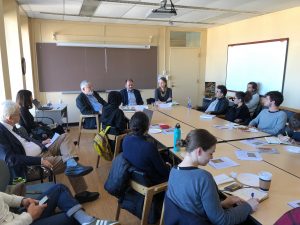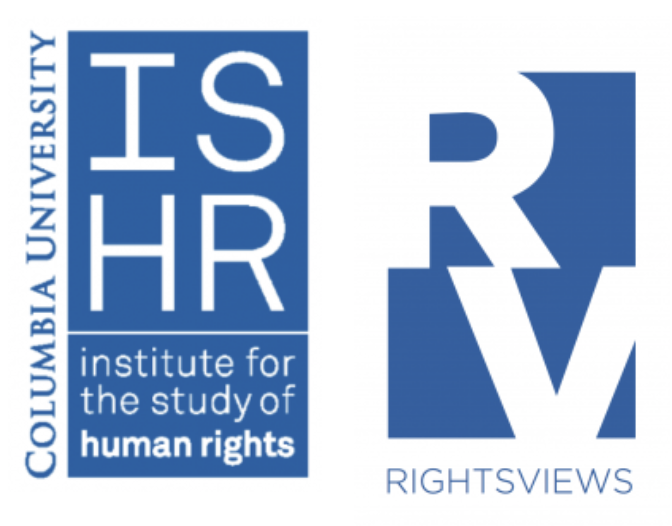South Africa’s transition from apartheid to multi-racial democracy and subsequent Truth and Reconciliation Commission (TRC) are often held up as a gold standard to be replicated by countries emerging for civil war or dictatorship. While recognizing the importance of elections, forgiveness, and truth, Fanie du Toit, Executive Director of the Institute for Justice and Reconciliation in Cape Town, South Africa, and Virginie Ladisch, head of the Children and Youth program at the International Center for Transitional Justice, sought to challenge audience members to complicate our narrative of the political transition and reconciliation in South Africa and why and how it has and hasn’t worked.
In the popular imagination South Africa’s racially segregationist apartheid regime was brought to an end by democratic elections in 1994. Following the seemingly superhuman leadership of Nelson Mandela, South Africans forgave each other for the crimes of the past and agreed to build a future together. Ever since the TRC’s mandate ended in 1998 other countries transitioning from civil war or dictatorship to liberal democracy have looked to the South African model.
Complicating this narrative is the focus of du Toit’s new book, “When Political Transitions Work,” which is based on extensive interviews with the people at the highest levels of South African politics during the transition, thousands of pages of documents from the era, and du Toit’s scholarly pursuits and substantial practical experience with transitional justice across Africa and the Middle East. Du Toit emphasizes the importance of relationships in political transitions, and the centrality of the recognition of “pervasive, unavoidable interdependence” as a foundational building block of reconciliation. He sheds light on the often-forgotten institutions that guided South Africa through the negotiations to end apartheid, the successes and failures of the TRC, and the failure to deliver economic justice. Ultimately, he persuasively argues, transitions will only work when participants acknowledge their interdependence.
The recognition of interdependence in South Africa did not originate in forgiveness says du Toit, though this was important later, but instead from hard-edged realistic calculations in all camps. As the country tottered on the brink of civil war in the late 1980s and early 1990s, Mandela and his counterpart F.W. de Klerk realized the only future was a shared one. South Africa would not survive otherwise. “We reconcile not because we choose to, we reconcile because we have to,” said Mr Du Toit, “Reconciliation is not for the dreamers or romantics, it’s for the realists.”
While Mandela and De Klerk negotiated in the early 1990s, crucial and often-forgotten new institutions were created which became spaces for inclusivity and fairness. The National Peace Accord, a body which eventually included civic, business, religious, and political leaders, was a non-partisan venue for politicians to denounce political violence and discuss what a transition might look like. In every region of the country the NPA created local bodies and trained of local peacemakers to promote trust and reconciliation, mediate conflicts, facilitate agreements on the operation of local public political events, and liaise with the local police and judiciary. It brought the transition and reconciliation to local communities and created space where a new way of dealing with conflict could develop leading up to the 1994 election. The NPA was also beginning to address the socio-economic violence caused by apartheid, a crucial issue for the millions  of Black South Africans denied opportunity because of their skin. The NPA, according to du Toit, still had a lot of offer when it was dissolved after the 1994 elections.
of Black South Africans denied opportunity because of their skin. The NPA, according to du Toit, still had a lot of offer when it was dissolved after the 1994 elections.
Outside South Africa the TRC is probably the most known, and replicated, part of South Africa’s transition. Inside the country, it’s arguably the most contentions. Between 1996 and 1998 the country sat on the edge of it’s seat as victims and perpetrators of political violence gave emotional public testimony on what they had endured or committed. At the end, the commission released a list of recommendations, including the redistribution some of the ill-gotten economic wealth created during apartheid. These recommendations were by and large swept under the rug after South Africa embraced the free market consensus as espoused by western financial institutions in the late 1990s.
Du Toit has a more positive outlook on the TRC than many of his fellow South Africans – in “When Political Transitions Work” he points out that the TRC helped acknowledge and restore the dignity of victims, established accountability, and produced a public record of violations to act as a permanent reminder – no mean feat considering South Africa’s particularly tortured history. While many White South Africans did not necessarily want to hear victim’s testimony, they couldn’t ignore it, and eventually it forced White South Africa to at least acknowledge what happened under the Apartheid regime. Du Toit’s criticism of the TRC concentrates on the failure of the government to follow through on ameliorating the socio-economic violence caused by apartheid.
As the 1990s drew to a close, the recognition of mutual interdependence began to fade. The abandonment of the NPA and other structures that guided South Africa through the negotiations eliminated a neutral space where political, business and civic interests from all corners of South Africa could meet and discuss how to create a peaceful and just society. By neglecting to address the socio-economic violence of apartheid, racialized wealth disparities have persisted, driving communities further apart and creating the impression of two different South Africas.
While outsiders often point to South Africa’s transition as a stunning success, within the country the perception is far more mixed. Recalling her first visit to South Africa in 2000, Ladisch shared that at the time “reconciliation” was considered a bad word to many. Over the last two decades since the TRC undertook its mandate, the word “reconciliation” has come to mean different things to different people at different times. At times it’s seemed like the South African reconciliation failed, at other times the process seems to be going well. At salient moments, like the death of Nelson Mandela in 2013, South Africans engage in a new round of collective soul searching, and develop a new outlook on reconciliation, based as much on past experience as the contemporary political climate.
Recognizing that South Africa has become an example to many other countries trying to reconcile after years of conflict, Ladisch warned against a “copy-paste” prescriptive approach to transitional justice. “There is no recipe to transitional justice, just different approaches,” she said. South Africa arrived at reconciliation through a realization of interdependence. The political transition was guided and shaped by uniquely created inclusive and fair institutions which mirrored the prior realization. Truth telling was valuable, but to some, the failure to deliver socio-economic justice, has poisoned the word reconciliation. Instead of copy-pasting a South African-style TRC, countries coming out of conflict or dictatorship would do better to build their own fair and inclusive institutions – whether that be a truth commission, reparations bodies, or a new constitution – which reflect the fundamental principle of reconciliation as interdependence.
By James Courtright
